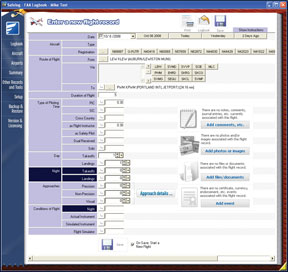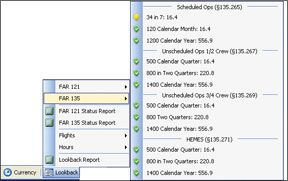Task one in looking at logbook software is figuring out what you want to log and why. If youre not detail-oriented and only care about when your last BFR or IPC was, then anything more than a Post-It on the corner of your computer monitor is probably a waste.
If you need to track duty time, watch the numbers for pilots and aircraft in a school or business, track time for tax reasons or are in the grind of pursuing higher

ratings, logbook software can be a godsend. We reviewed over a dozen systems to keep the numbers in the right columns. Here are our top picks to meet the variety of needs out there.
AircraftLogs.com
This website is geared mostly to corporate users and flight departments, but has a lot of utility for private aircraft owners as well. Its strength is in tracking aircraft time as it meets all the FAA requirements for electronic logbooks for aircraft-including electronic signatures. Why is this useful? First, if your shop is willing, they can access any of your aircraft records at a glance and cut down their admin time by signing you off electronically. Second, part of the service is scanning in all your aircraft documents and backing them up (you can also upload more on your own at any time). Also, ADs and Service Bulletins are automatically retrieved by the system, warnings flags for time-limited parts and inspections pop up automatically … the list goes on.
The system is integrated with a pilot logbook for tracking times and expenses. If all you care about is your personal times, then AircraftLogs.com is probably overkill. But for flight departments or for individuals who tightly track the purpose of each flight for tax reasons, the system lets you customize and generate reports to meet any need. This includes the IRS requirements for personal use of corporate aircraft.
There are a lot of nice touches to the service, such as all the scanned documents undergoing optical character recognition so they are searchable. You can customize access to let several users get into the data at different levels. Toll-free support is available from real human beings (with Midwest accents).
The pilot logbook part of the interface is arguably the weakest item without the smooth auto-entry and error-checking we see in some PC logbook software. But the product is growing and wed expect to see this added in the future.

We think the service is worth a look for aircraft owners and those managing several pilots and/or aircraft. The fees start at $30/month and go up from there. You can get a pilot logbook only for $9/month. You can schedule a free web demo to really get a sense of the scope of the service.
Safelog
Safelog is the walk-away winner for a full-featured, digital pilots logbook. We could use virtually all the features intuitively. The software runs on a PC, a PDA (Palm or Windows Mobile) and a website (www.safelogweb.com) and all three can synchronize. The data is easy to import and export. The logbook is vastly customizable to show any kind of data you want, but its set up we’ll with defaults that will work for most users. There are handy quick-entry items to make the logbook chore easier. Its also the most international with separate versions for FAA, JAA, CAA and Australian users.
Other great features are automatic lookup of airports, integrated help windows as youre learning your way around and some tools for flight currency and FAA test readiness. Safelog was the only software that easily let you enter baseline times from your old paper log so you could just start using a digital log without having to add all your old flights in. There are plenty of options to track expenses. Our test of customer support got an immediate response. Future features will include automatic schedule importing for airline pilots.
The interface is quite dependent on pop-up windows, which can get annoying. It also seemed the slowest product when we imported a large database (several thousand flights). It doesnt track aircraft times as is the least Vista-friendly (the

web-interface works on any computer however).The interface has a “cute” logbook look. We’d rather have less cute and a better fit to a variety of screens. The cost is $79-95 for the PC software and web access for three-years of use and updates.
Logbook Pro
If the thought of a logbook with pivot tables built in excites you, then Logbook Pro is for you. If you don’t know what a pivot table is, you might still like the software if you like a more computer-like interface.
Logbook Pros geek power is its greatest strength and weakness. Take the great currency and lookback feature. At a click you can see virtually any kind of currency you might want for flight times, Part 121 or 135 ops, and more. The catch is you must set up several of these currencies yourself and the process takes some explaining. To Logbook Pros credit, there are three hours worth of tutorials online to help. Our experience was that we needed to spend at least an hour viewing these tutorials to become as proficient with Logbook Pro as we were with other software after 20 minutes of trial and error.
Once you get the software configured, its fast and powerful, even with huge databases. It can sync across multiple computers or with your PDA, but there’s no web interface. Simple expense tracking is available. The cost varies from $69.95 to $149.95 depending on features, but you get a lifetime of free upgrades.
AvJournal

For basic record-keeping and currency reminders, AvJournal hits the sweet spot. It tracks what most pilots would expect from a logbook and little more. The data import function is simple but works well. You can add some basic aircraft maintenance tracking, such as annual inspections. Reporting of times is more limited than full-featured software, but its adequate for most pilots needs.
We particularly liked how aircraft profiles could be made active and inactive, so little-used aircraft wouldnt clog your lists. We also liked how instrument types for aircraft ranged from “EFIS” to “Seat of the pants.” Wed like to see a better use of Javascript to make entering times easier and quicker, but, overall, AvJournal delivers a great, basic logbook for $3.95/month.
AvTracker
AvTracker really isn’t pilot logbook software at all. Its designed to track basic time and expenses for aircraft and warn about upcoming maintenance due dates. Its simple and delivers exactly whats promised. It wont populate an 8710 form like the more sophisticated programs, but it will track your BFR and overall currency, and warn you when they get old. The software can track multiple pilots and multiple

aircraft and could be just the ticket for partnerships or clubs as we’ll as sole owners.
It stands alone in simply dividing up costs between several owners or pilots at the end of the day. There’s no billing system built in, but it sure makes all the math and record-keeping easier. Its not a true electronic recordkeeping system like AircraftLog.com, however. The cost is $79 for a single-owner version and $129 for aircraft with multiple owners.
Electronic Pilots Logbook
Electronic Pilots Logbook (EPM) is really a front end for an Access database, but its nicely done and worth the $39 price tag if a basic database is what you want. A built-in airport database is a plus. Importing of old data takes a bit more work to set up than other software, but its reasonable. There are additional fields for Hobbs in and out times as we’ll as BFR and IPCs.
The fact that it uses Access means it runs in a non-standard window that may have you searching for a minimize and close button at first. If you don’t have Microsoft Access, be sure to download the version of EPM with the Access Runtime.
If you think electronic logbook keeping is right for you, pick a program or two from this list that may match your needs and give it a try. For some of us, digital is the only way to go. For the rest, Post-Its and paper still get the job done.

